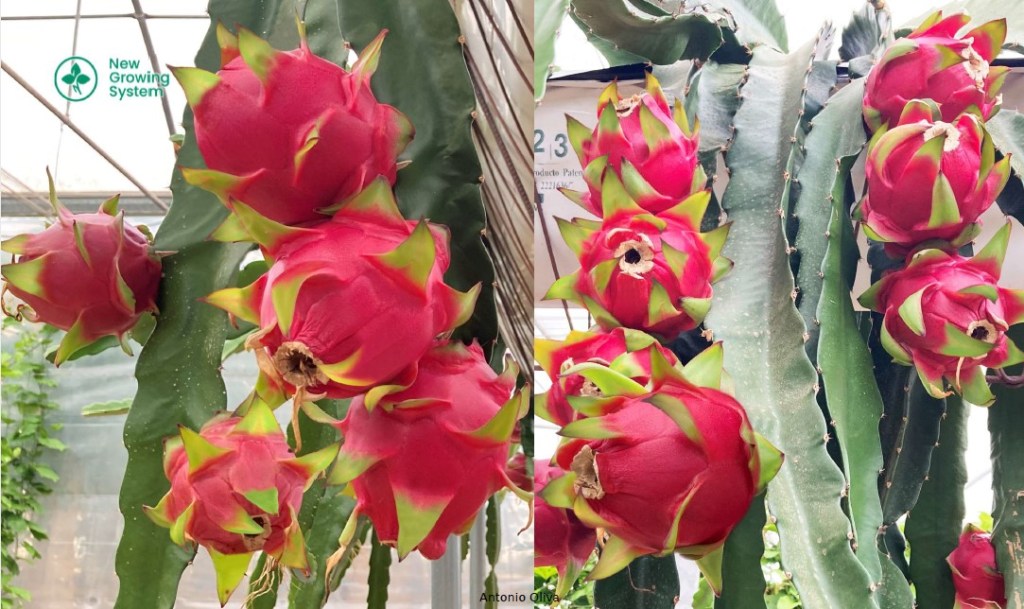En este momento, la pitaya (en su variedad Caramel of Desert) es el principal cultivo que abordamos en nuestros invernaderos hidropónicos. ¿Por qué hemos elegido esta fruta? Lo hemos hecho porque consideramos que es una de las que tiene mayor proyección de consumo en los próximos años. Y ello es debido a la continua mejora en la calidad del producto que los agricultores van generando. Además de por sus enormes propiedades respecto a la salud.
La pitaya, también conocida como pitahaya o fruta del dragón, tiene su origen en centro américa. Aunque entre los botánicos se la conoce y describe desde el descubrimiento del continente por los españoles, no es hasta fecha muy reciente (1995) que su consumo se ha popularizado en el ámbito alimentario. Antes de ello se la ha valorado por las características ornamentales de la planta y lo espectacular de su aspecto durante la floración. La gran eclosión se produce desde el momento en que el gobierno vietnamita incentiva a sus agricultores para que planten y comercialicen pitaya. Por eso hoy, suele ser la fruta de origen vietnamita la que puebla en su mayoría los lineales de los mercados europeos.
Se trata de una planta cactácea que, por tanto, presenta muy pocas necesidades hídricas. En el mercado la encontramos con sus dos característicos colores exteriores, amarillo y rojo, y sus diferentes aspectos de la pulpa, desde el blanco hasta el rojo intenso pasado por el rosado. Conforme los agricultores han ido creando nuevas hibridaciones esta fruta ha ido mejorando en su sabor y dulzor.
Elementos nutricionales
Su aspecto es muy atractivo y su consumo muy sencillo debido a lo fácilmente que se retira la cáscara exterior. La tonalidad púrpura intensa de algunas variedades resulta sumamente estética. Ello hace que la experiencia de consumo no se quede sólo en aspectos gustativos sino también en los visuales.
Composición nutricional media por 100 gr.
- Calorías: 54
- Agua: 84,4 %
- Proteínas: 1,4 gramos
- Grasas: 0,40 gramos
- Hidratos de carbono: 13,2 gramos
- Fibra: 0,5 gramos
- Vitamina C: 8 miligramos
- Calcio: 10 miligramos
- Hierro: 1,3 miligramos
- Fósforo: puede llegar a 26 miligramos
- Es de destacar también su alta cantidad de antioxidantes, donde destacan las Betalaínas, los Hidroxicinamatos y los Flavonoides

Pero son sus potentes posibilidades respecto al cuidado de la salud las que mayormente incitan a su consumo. Es de alto contenido en agua (cercano al 90% de la misma) y la pulpa es rica en hierro, calcio y fósforo. En ella abundan las vitaminas B, C y E.
Artículos médicos
La National Libray of Medicine del gobierno de los Estados Unidos recoge en este momento 244 artículos científicos sobre las propiedades médicas de la pitaya. El crecimiento del interés de la comunidad científica es palpable, pasando en 2001 de un solo artículo a los 65 del año 2022. El lector interesado en revisar alguno de ellos podrá acceder a la web del NLM pulsando sobre la imagen.

Ventajas para la salud del consumo de pitaya
- La producción reforzada de glóbulos rojos, blancos y plaquetas refuerza el sistema inmunológico.
- Favorece el buen estado de la microbiota intestinal, lo que ayuda a controlar los niveles de glucosa. Esto la hace adecuada para la prevención y el tratamiento de la diabetes
- El hierro y la vitamina C facilitan la prevención de la anemia
- La vitamina C, a través del refuerzo de la producción de colágeno, es de ayuda en el mantenimiento óptimo de los sistemas muscular y óseo.
- El gran contenido en antioxidantes constituye un gran remedio contra el envejecimiento prematuro
- La pitaya es un gran aliado contra el estreñimiento, facilitando, además, la diuresis.
- Sus semillas aportan ácidos grasos esenciales, especialmente Omega 3. Esto sirve de ayuda en los procesos inflamatorios y en la lucha contra el colesterol.
- Su alto contenido en agua y muy bajo en carbohidratos es un aliado esencial en las dietas de adelgazamiento.
- La vitamina C junto a los Flavonoides, Polifenoles y Betalaínas actúan como antioxidantes y antiinflamatorios. Esto evita el daño causado por los radicales libres a las células, protegiendo así contra enfermedades crónicas como el cáncer, la diabetes o la artritis. Esta combinación de elementos puede mejorar también la respuesta de nuestro sistema inmune ante determinados virus y bacterias.
Caramel of Desert
La variedad que cultivamos en Mochana Green es la Caramel of Desert, una hibridación propiedad de New Growing System. Desde nuestro punto de vista, esta variedad presenta los mejores índices de calidad que en este momento pueden encontrarse en el mercado. Tenemos plantadas dos variedades de pitaya de pulpa roja (Hylocereus sp / Caramel of Desert R1 y R2) y una de pitaya de pulpa blanca (Hylocereus sp / Caramel of Desert R3)
Todas ellas se caracterizan por generar frutos cuyo peso medio suele estar por encima de los 400 gramos, superando así la media de lo que podemos encontrar en el mercado. Así mismo, los grados brix que obtenemos con ellas oscilan entre los 18 y los 21, lo que les proporciona un sabor y dulzor excepcionales.

También puedes ver este artículo en vídeo.
